Physical Address
304 North Cardinal St.
Dorchester Center, MA 02124
This chapter deals with abnormalities of position and connection of the major systemic venous channels that drain to the heart. We also discuss abnormal persistence of the valves of the embryonic systemic venous sinus. The anomalies included vary widely, ranging from asymptomatic variants to those that carry serious hemodynamic significance. The anomalies producing abnormal hemodynamic effects modify both the clinical presentation and the subsequent surgical repair. The asymptomatic variants, on the other hand, might dictate changes in the interventional or surgical approach. Since most of the lesions are asymptomatic, their precise frequency is not known. Nonetheless, clinically relevant anomalies are infrequent in the setting of lateralized atrial appendages. In contrast, systemic venous return is always abnormal anatomically in all patients with isomeric atrial appendages, albeit that the patterns of venous return themselves can produce quasi-usual or quasi-mirror-imaged patterns of drainage (see Chapter 26 ). Unprecedented growth in the field of noninvasive cardiac imaging has improved the preoperative detection of the hemodynamically relevant anomalies. Nonetheless, diagnostic errors related to anomalies of systemic venous return are still frequently encountered. It is this finding that underlies the importance of careful preoperative evaluation. It is also the case that, for these lesions, an in-depth knowledge of the morphogenesis of the systemic veins can help in understanding the wide spectrum of anomalies that might be encountered, in addition to guiding the surgical repair. Therefore we begin with a review of the developmental evolution of the systemic venous system. We then discuss the individual anomalies and their clinical relevance.
Normal venous development is a process of progressive appearance of a series of paired venous structures, the development of anastomotic channels between them, and the eventual selective regression of certain components. Initially, the systemic venous tributaries are bilaterally symmetric. Three sets of channels join together on each side, opening to the developing heart tube through paired channels known as the sinus horns. The sinus horns themselves open caudally into the atrial component of the developing heart tube. When first recognized as draining to the heart tube, there are no anatomic landmarks that permit the distinction of a separate “sinus venosus,” or systemic venous sinus, such as that found in the hearts of lower vertebrates (see Chapter 3 ). Instead, the three major venous channels from each side of the developing embryo drain into each horn. From medial to lateral, the channels are the omphalomesenteric or vitelline veins, the umbilical veins, and the common cardinal veins ( Fig. 27.1 , left ). The superior and inferior cardinal veins, which drain the cephalic and caudal regions of the embryo, respectively, join together initially to form bilaterally symmetric common cardinal veins. Subsequent to the development of anastomotic channels throughout the embryo between the right- and left-sided venous channels, the flow is shifted to favor the developing right side of the atrial component of the heart tube. Concomitant with this shift to right-sided dominance, the left sinus horn rotates within the developing atrioventricular junction, moving around the fulcrum provided by the dorsal mesocardium, which itself provides the portal of entry for the developing pulmonary vein (see Chapter 3 ). After the rotation, the left-sided venous channel, which has regressed significantly in size, opens inferiorly and caudally within the systemic venous sinus, itself now distinguished from the remainder of the developing right atrium by the formation of the so-called venous valves ( Fig. 27.2 ). A gradual regression of the left-sided vitelline and cardinal veins follows, with increasing prominence of the right sinus horn. Eventually, the entirety of the systemic venous sinus within the confines of the valves becomes incorporated as the smooth-walled venous component of the morphologically right atrium, with the opening of the right common cardinal vein becoming the orifice of the superior caval vein, and that of the right vitelline vein becoming the entrance of the inferior caval vein. The mouth of the left sinus horn persists as the orifice of the coronary sinus (see Fig. 27.1 , right ). The initial anastomotic connection between the right and left superior cardinal veins enlarges and becomes the left brachiocephalic vein, often known as the innominate vein. If development proceeds normally, there is regression of the component of the left superior cardinal vein initially extending from the anastomotic channel to the developing left atrioventricular junction. Its remnant forms the oblique vein of the left atrium and the ligament of Marshall ( Fig. 27.3 ).
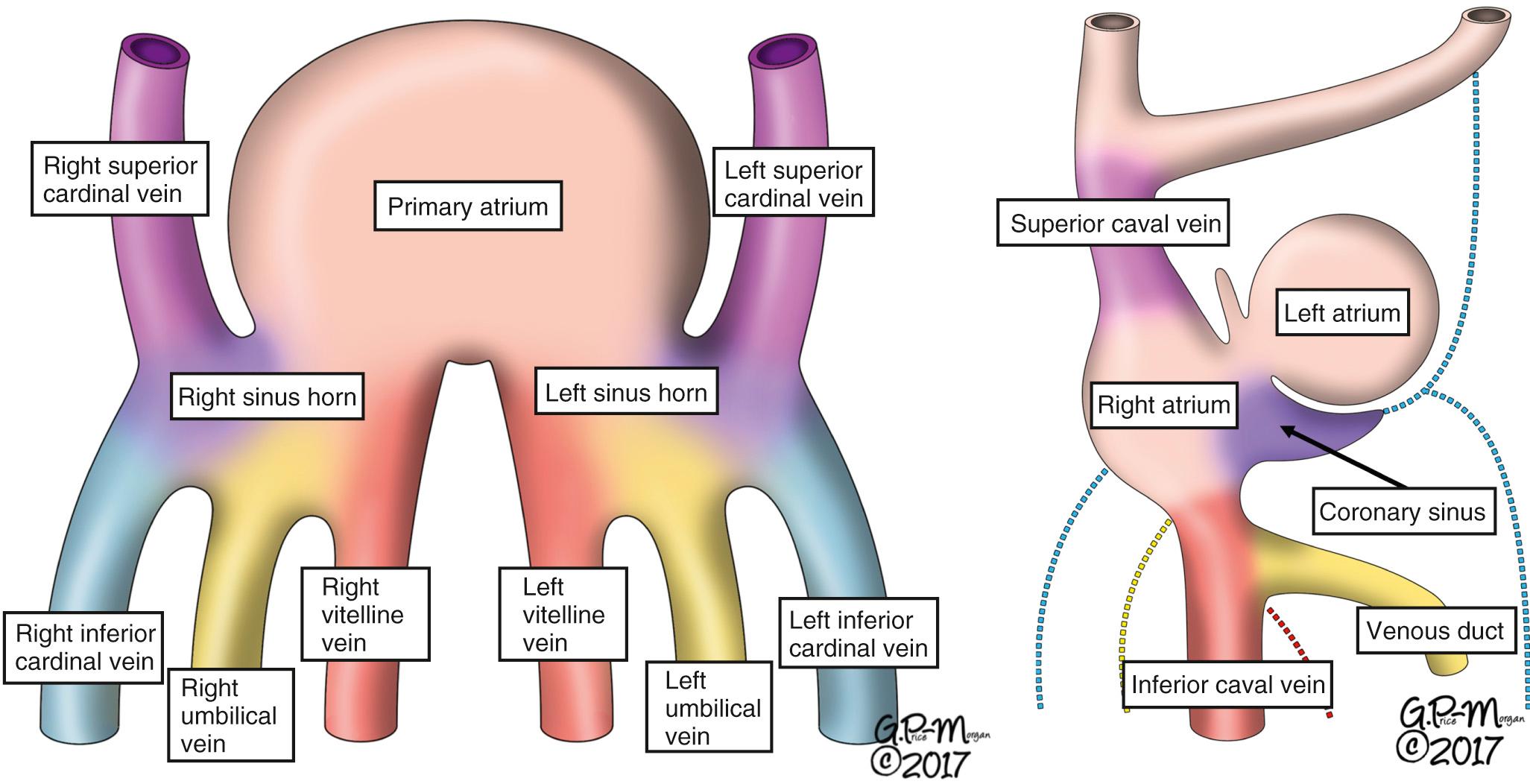
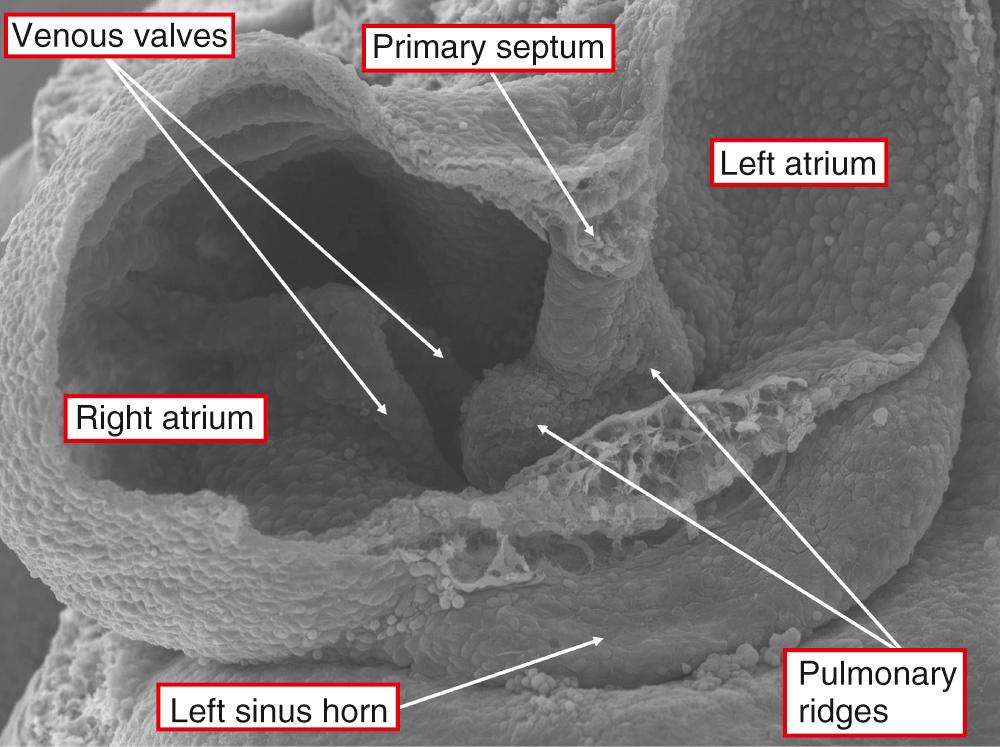
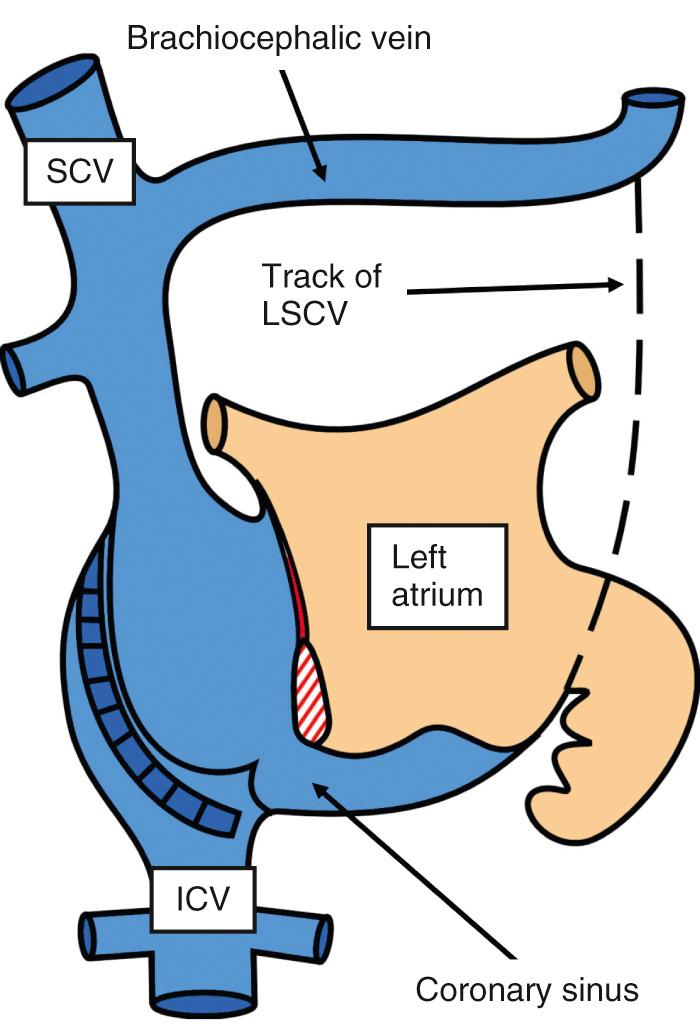
With ongoing development, there are further changes in the valves of the systemic venous sinus. The right-sided valve remains prominent during embryonic life, while the left valve regresses markedly, eventually fusing with the margins of the oval fossa. The right valve also subsequently regresses for its greater part, except for portions that persist as folds related to the orifices of the inferior caval vein, known as the eustachian valve, and the coronary sinus, known as the thebesian valve. In the light of the occasional coexistence of anomalies of pulmonary and systemic venous drainage, the development of the pulmonary venous system is also of significance. The developing lungs are derived from the primitive foregut. They share their early vascular supply with the gut via a splanchnic plexus. This plexus initially drains the intraparenchymal pulmonary tissues to the cardinal venous system. With normal development, these connections are lost, with the pulmonary vein itself canalizing in the dorsal mesocardium. It gains its entrance to the developing morphologically left atrium between the so-called pulmonary ridges (see Chapter 3 ).
Thus three systemic venous systems were initially present within the embryo, the yolk sac, and the placenta: the vitelline, umbilical, and cardinal systems (see Fig. 27.1 , left ). The vitelline system largely becomes a vascular network draining the liver. These channels are predominant on the right side of the embryo, maintaining their connection to the right side of the systemic venous sinus through structures known as the hepatocardiac channels. The right-sided vitelline vein ultimately becomes the terminal posthepatic portion of the inferior caval vein (see Fig. 27.1 , right ). The umbilical veins are also initially paired structures. They lose their direct connection to the systemic venous sinus and anastomose to the hepatic sinusoids. The right-sided umbilical vein then regresses, while the left umbilical vein enlarges to become the channel that brings blood from the placenta to the embryo. Forming an anastomosis with the hepatocardiac channel, it becomes the venous duct, or “ductus venosus.” While these changes have been taking place, additional changes within the developing abdominal region of the embryo underscore the formation of the inferior caval vein. An understanding of these changes provides significant insight to the potential malformations involving this venous channel. By the fifth week of gestation, paired subcardinal veins have developed medial to the inferior cardinal veins, serving initially to drain the forming urogenital sinuses. When traced cranially, these subcardinal veins empty on both sides into the caudal cardinal veins ( Fig. 27.4 , left ). Anastomotic channels develop between the two subcardinal veins as well as between the right subcardinal and hepatocardiac channels. The right subcardinal vein eventually becomes predominant, developing into the infrahepatic segment of the inferior caval vein. This, in turn, joins the right vitelline vein, which provides the entrance of the inferior caval vein into the morphologically right atrium. With continued growth of the trunk of the embryo, yet another system of veins, the sacrocardinal system, arises dorsal and caudal to the inferior cardinal system. Anastomotic channels that form between the subcardinal and sacrocardinal systems on the right side produce the renal segment of the inferior caval vein, while the distal portions of the right sacrocardinal vein persist and enlarge to produce its most inferior portion (see Fig. 27.4 , right ). Concomitant with these developments of the paracardinal systems, aside from their most proximal portions, the inferior cardinal veins themselves gradually involute. This involution occurs concomitant with the formation of the supracardinal venous system. This system becomes converted into the azygos and hemiazygos veins on the right and left sides, respectively. These channels, in turn, terminate cranially in the right cardinal venous system ( Fig. 27.5 ). The definitive inferior caval vein therefore has multiple embryologic origins. Its terminal suprahepatic portion is derived from the right vitelline vein. The infrahepatic segment arises from the right subcardinal vein, while the intermediate segment is derived from the anastomotic channels initially developed between the subcardinal and sacrocardinal veins. The most inferior segment arises from the right sacrocardinal vein. The azygos and hemiazygos veins are derived from the supracardinal system (see Fig. 27.5 ). Abnormal development of these multiple abdominal venous channels makes it possible for the supracardinal venous system to become dominant. This results in the venous return from the lower abdomen returning through the azygos system of veins to either the right- or left-sided superior caval vein. The inferior caval vein is itself interrupted between the abdominal and hepatic segments, with the hepatic segment draining only the blood from the liver and the portal venous system back to the heart.
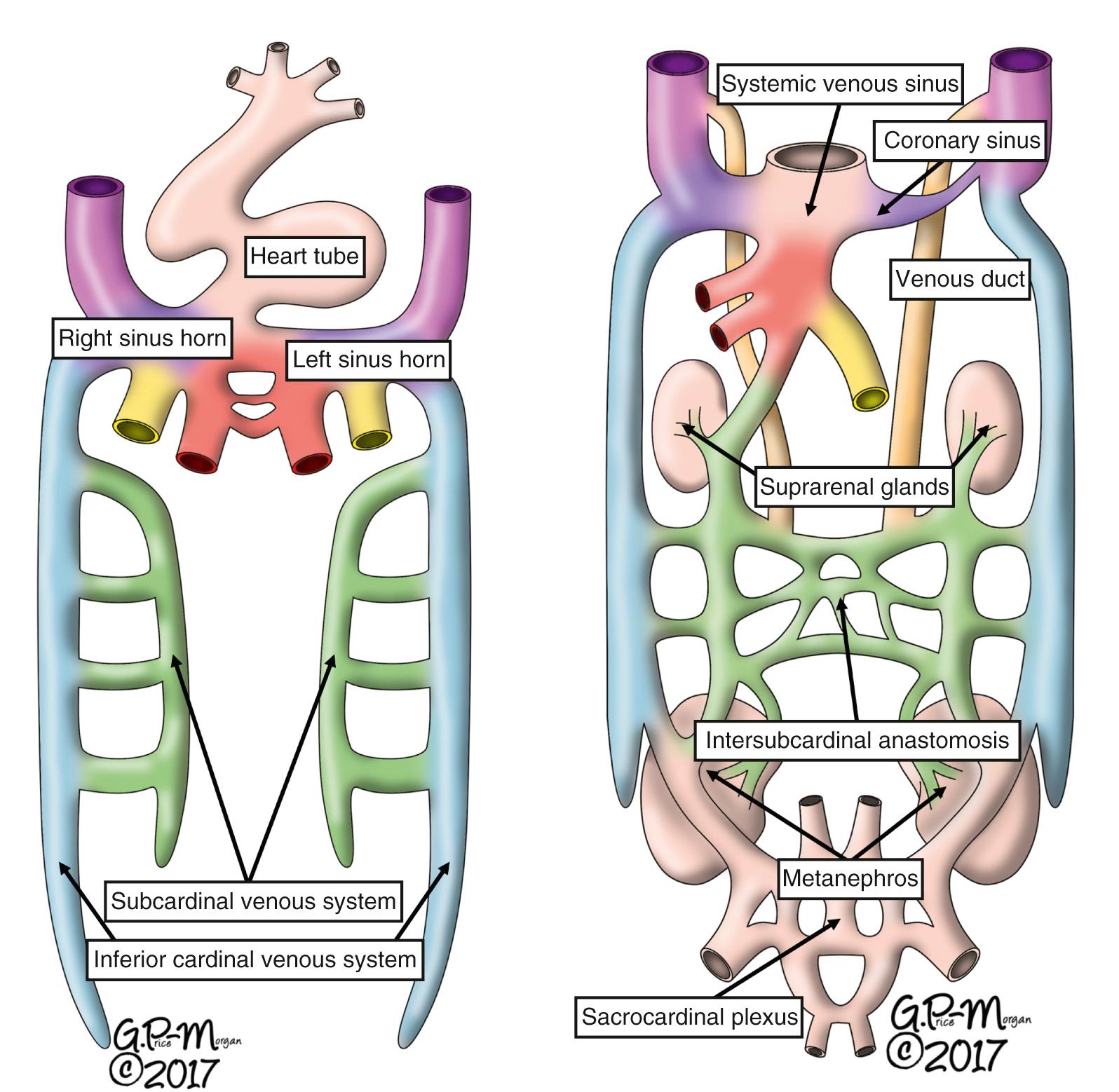
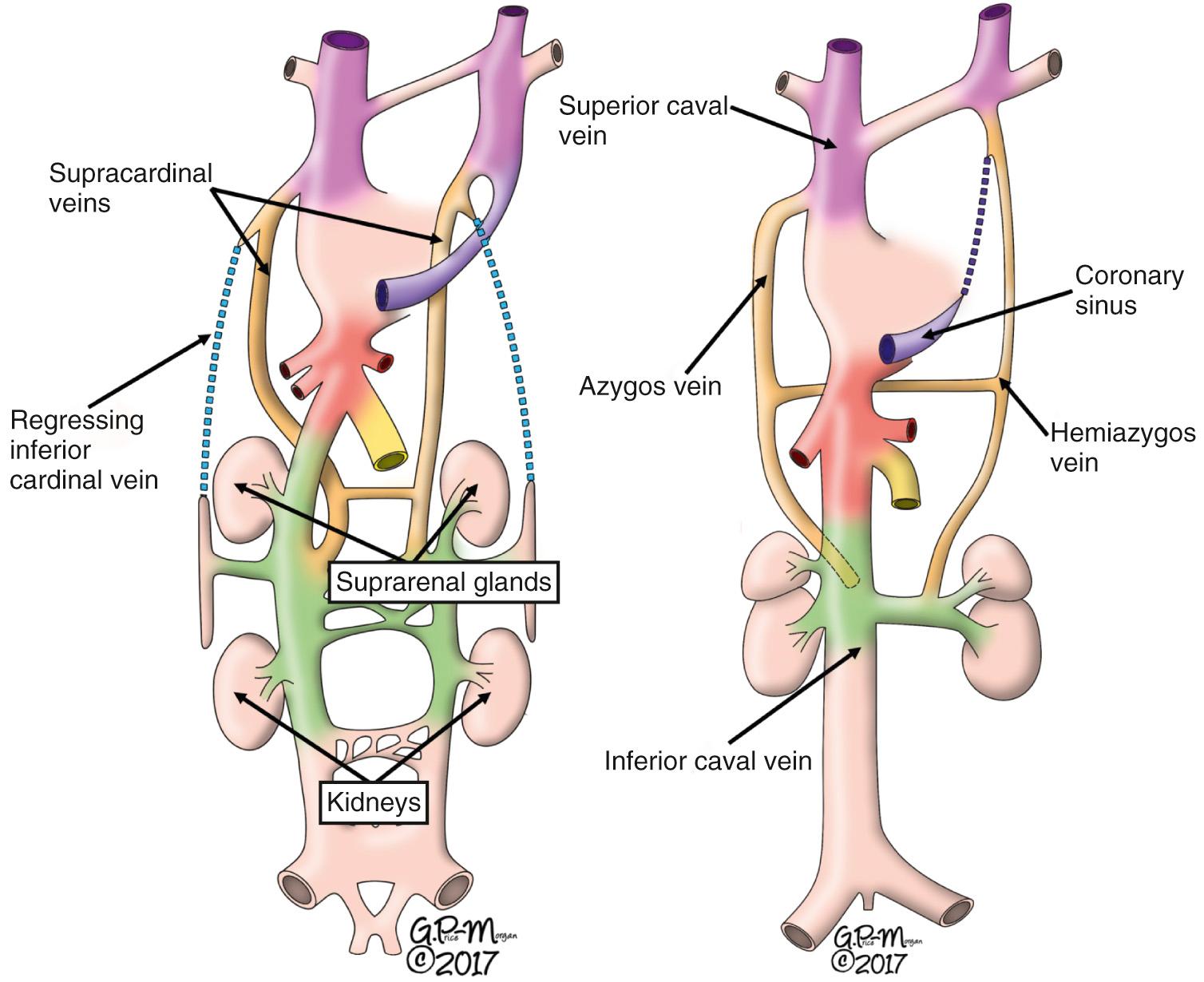
The venous development discussed thus far has presumed the development of anastomotic channels and the connection of the systemic venous sinus to the right-sided atrium. This process produces the morphologically right atrium, which in the normal heart contains the entirety of the embryonic systemic venous sinus. The left side of the initial atrial component of the heart tube, together with the developing pulmonary veins, becomes the morphologically left atrium. Concomitant with these changes, and as explained in Chapter 3 , the appendages balloon from each side of the atrial component of the heart tube. The appendage growing to the right assumes its typically triangular shape, incorporating the cephalic part of the valve of the systemic venous sinus to form the terminal crest and the spurious septum, or “septum spurium.” The appendage growing from the pulmonary side is much narrower. It has no relation with the valves of the systemic venous sinus and therefore lacks a terminal crest. All of this occurs concomitant with the development of anastomoses from the left to the right side. If the anastomoses develop in right-sided to left-sided fashion, the left-sided atrium will incorporate the systemic venous sinus and become the morphologically right atrium, while the right-sided atrium becomes the morphologically left atrium. This will produce the mirror-imaged atrial arrangement, also known as “situs inversus.”
However, in certain circumstances the process of lateralization does not occur. The systemic venous tributaries can then retain their bilateral symmetry. This lack of lateralization occurs in two forms (see Chapter 26 ). In the first, the valves of the systemic venous sinus are incorporated bilaterally, along with formation bilaterally of morphologically right atrial appendages. This process “squeezes out” the anlagen of the primary pulmonary vein so that there is either no atrial site for its drainage, or else its site of drainage is restricted and anomalous. Therefore, such right isomerism is characterized by the bilateral presence of appendages with right morphology, bilateral sinus horns together with bilateral systemic venous drainage, as well as anomalous pulmonary venous drainage. In the other pattern, there is bilateral growth of morphologically left structures. Consequently, the pulmonary venous component predominates in relation to the systemic venous tributaries. The major systemic venous channels make anomalous connections to the atrial chambers, which have morphologically left appendages bilaterally. The common cardinal veins are more successful in this respect, tending to enter the atrial roof on each side in the absence of a terminal crest. The hepatic veins also enter the atrium directly, often bilaterally. In contrast, the venous return from the lower body usually continues through the supracardinal azygos system, draining to one or other of the superior cardinal veins to produce azygos continuation of the inferior caval vein. In those cases, with isomeric left appendages in which the inferior caval vein does achieve a direct atrial connection, it tends to do so separately from the hepatic veins. Because of these developmental associations, anomalous systemic and pulmonary venous connections are part and parcel of the syndromes of isomerism (see Chapter 26 ).
During their development, the systemic venous channels receive contributions from multiple sources and undergo a complex process of remolding and regression. Therefore it is not surprising that a variety of anomalies can be encountered in postnatal life. Although anomalous connection of a solitary systemic vein is the most common malformation encountered, it is not uncommon to witness a combination of anomalies in a single patient. While the majority of these anomalies are simple anatomic variants with no consequences for the patterns of venous drainage, some have serious hemodynamic consequences. Traditionally, these anomalies have been classified according to their anatomic location. However, this system of classification provides limited information about the potential hemodynamic consequences and fails to provide any guidance toward management. With this in mind, we have chosen to classify the anomalies, particularly those involving the caval veins, on the basis of their connection, drainage, and course ( Box 27.1 ). As was discussed in the previous section, the connection of the systemic veins is always anomalous in patients with isomeric atrial appendages. Because of this, our discussion in this chapter is limited to the findings in patients with lateralized atrial appendages—in other words, either the usual or mirror-imaged arrangements.
Superior caval vein
Left superior caval vein to coronary sinus—with or without connecting vein
Absence of the right superior caval vein
Absence bilaterally of the superior caval veins
Inferior caval vein
Absence of the hepatic segment of inferior caval vein with azygos continuation
Superior caval vein
Left superior caval vein connected to the morphologically left atrium
Direct or unroofing of coronary sinus or via left upper pulmonary vein
Right superior caval vein connected to both the atriums
Right superior caval vein connected to the morphologically left atrium
Right superior caval vein connected to the left atrium, and left superior caval vein draining via the coronary sinus
Inferior caval vein
Inferior caval vein connected to the morphologically left atrium
Congenital
Acquired (postoperative)
Hepatic veins
Hepatic vein(s) connected to the morphologically left atrium
No pattern
Superior caval vein
Retro-aortic brachiocephalic vein
Retro-esophageal brachiocephalic vein
Double brachiocephalic vein
Intraatrial left superior caval vein
Inferior caval vein
Duplication of infrarenal inferior caval vein
Azygous and hemiazygous continuation of bilateral inferior caval veins
Union of left inferior caval vein via left renal vein with right inferior caval vein
Hemiazygous continuation of inferior caval vein via right renal vein
Left-sided inferior caval vein
Circumaortic left renal vein (circumaortic venous collar)
Circumcaval ureter
Absent inferior caval vein
Unroofing of coronary sinus with or without persistent left superior caval vein
Atresia or stenosis of coronary sinus orifice
Absence of coronary sinus
Prominent eustachian valve
Divided right atrium
Absent venous duct
Persistent venous duct (intrahepatic portosystemic shunt)
Extrahepatic portosystemic shunt (Abernethy malformation)
In the normal arrangement, all the systemic veins are expected to connect directly to the morphologically right atrium (see Fig. 27.3 ). On occasion, the systemic veins can connect in anomalous fashion, yet maintain their drainage to the right atrium. In most instances, anomalies of this kind have no or minimal hemodynamic relevance. Nevertheless, such anomalous connections can mandate modifications in the technique of diagnostic evaluation, and in interventional or surgical repair. As we have already commented, being hemodynamically inert, the exact prevalence of these anomalies remains unknown. Such patterns can involve either the superior or inferior caval veins.
A left-sided superior caval vein draining to the coronary sinus is the most common anomaly of the systemic veins. It results from failure of involution of the left superior and left common cardinal veins. Simultaneously, the anastomotic channel, which is the prospective brachiocephalic vein joining the left and right superior cardinal veins, is underdeveloped. A brachiocephalic vein does connect the left superior caval vein with the right superior caval vein in up to three-fourths of patients, but its size varies inversely with that of the left-sided vein. A good-sized connecting vein offers the possibility of ligating the left-sided vein without compromising the venous return from the head and left arm ( Figs. 27.6 and 27.7 ).
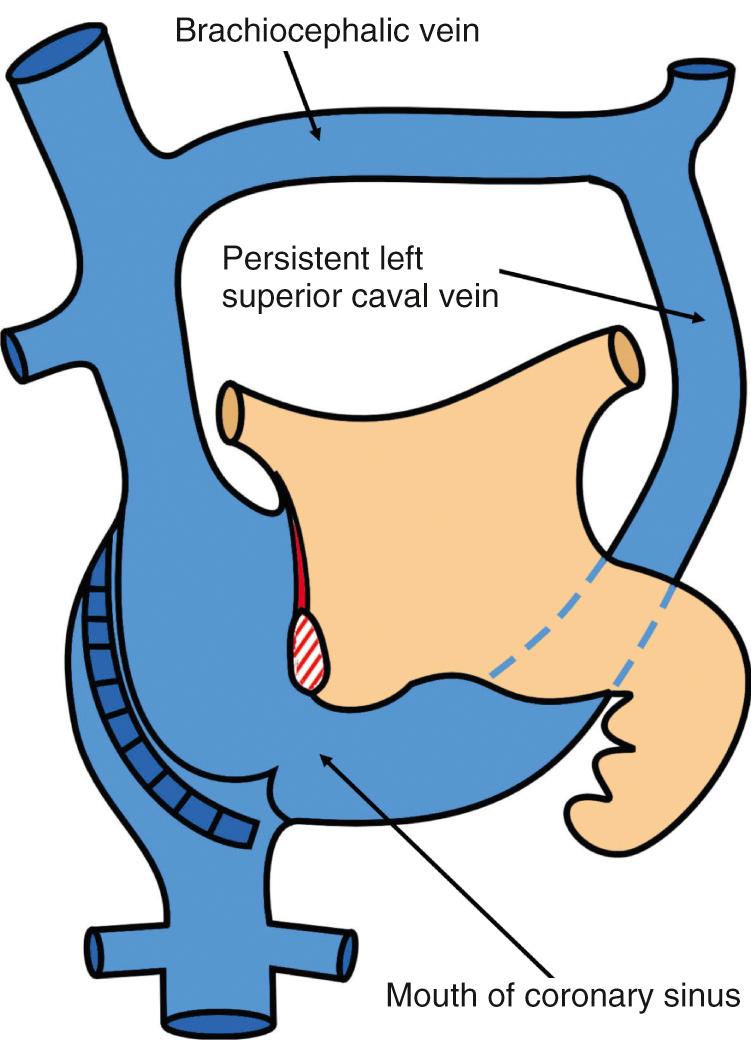
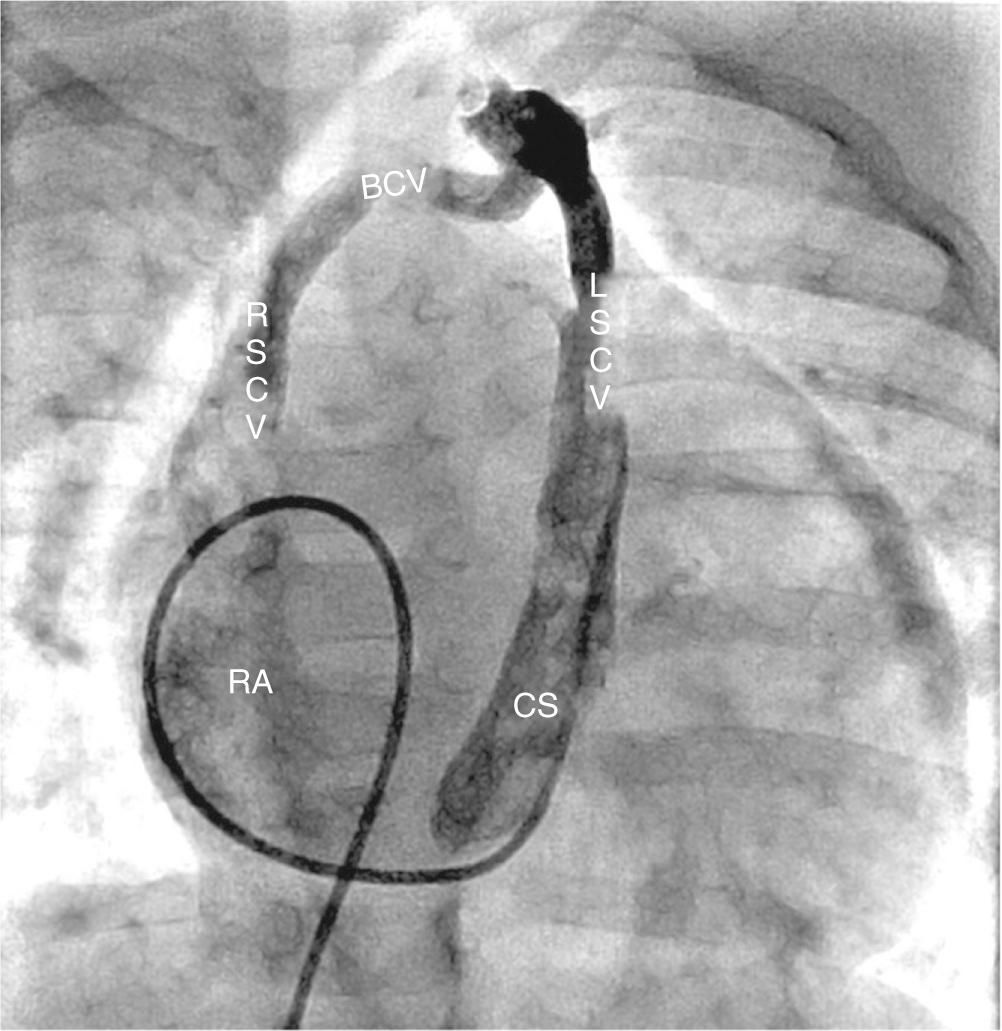
When present, the persisting left superior caval vein follows the course of the embryonic left cranial cardinal vein. It enters the pericardial cavity to the left of the left upper pulmonary veins, and runs posterior to the dome of the left atrium, having the mouth of the left atrial appendage to its left side. As it passes inferiorly, it accepts the hemiazygos vein and descends medially into the inferior atrioventricular groove. In nine-tenths of cases, the persistent left superior caval vein drains into the morphologically right atrium through an enlarged mouth of the coronary sinus. The lesion has been noted in almost 1 in 200 autopsy specimens in the general population but occurs in up to one-twentieth of patients with congenitally malformed hearts. A left superior caval vein was seen in 0.3% of series of autopsied heart specimens. Sometimes a left superior caval vein can reopen after construction of a partial or total cavopulmonary connection. Spontaneous closure of the left superior caval vein to the left atrium has also been encountered. These instances suggest that the lumen of the left superior caval vein obliterates, but does not disappear, remaining as a potential vascular channel.
Although persistence of the left superior caval vein has no direct effect on the systemic venous drainage, its anomalous connection to the coronary sinus has been shown, on occasion, to produce obstruction to adjacent cardiac structures ( Fig. 27.8 ). There are reports of the vein impinging on the vestibule of the mitral valve and causing obstruction to the inflow of the left ventricle, sometimes requiring surgical plication. Left-sided obstructive lesions themselves also occur at an increased frequency in patients having persistence of the left superior caval vein. However, the effect of such persistence is much more pronounced during placement of permanent pacemakers through left axillary venous puncture. The incidence of abnormalities of the sinus node and arrhythmia is also known to be higher in these patients, especially when there is absence of the right superior caval vein.
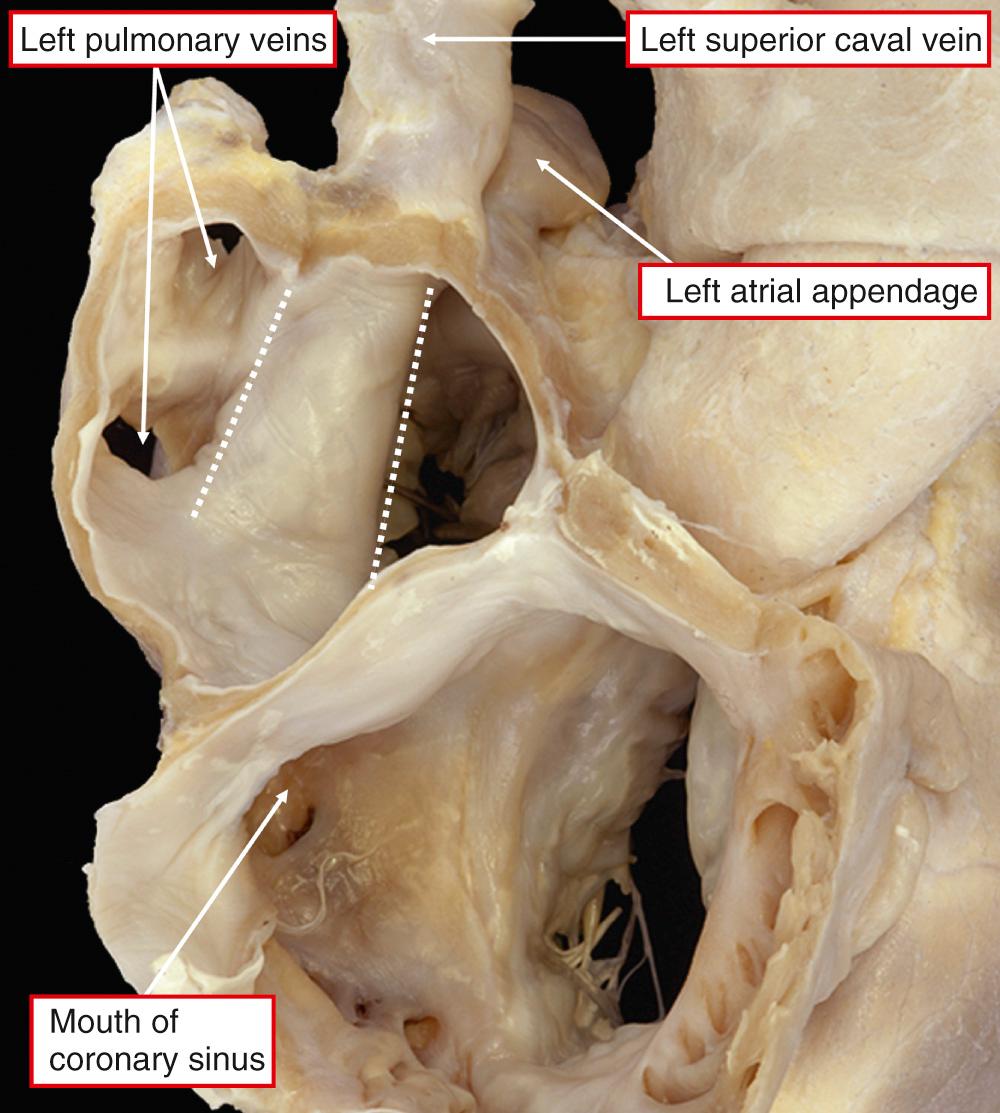
On occasion, the right superior caval vein can be absent, with the left superior caval vein providing the only source of drainage of blood from head and arms. Over 200 cases have been reported in the world literature, although it is suspected that, being clinically silent, this variant may remain largely undetected. In the absence of the right-sided channel, the left-sided vein receives the brachiocephalic vein and the azygos vein. However, the left-sided venous channel is not the mirror image of the right superior caval vein. Instead, this vascular channel has an origin and course exactly the same as that of the left superior caval vein (see Fig. 27.6 ). Hence, it drains via the coronary sinus in the majority of cases but may connect directly to the left atrium in some. In some autopsy specimens, a vestigial cord has been identified, which represents the remnant of the right superior caval vein. The anomaly results from involution of the right, instead of the left, superior cardinal vein during embryonic life. It is known to exist both as an isolated anomaly and in association with other cardiac malformations. Abnormalities of rhythm are common, more so with coexisting cardiac malformations, and are more pronounced in older patients. Once again, since drainage is normal, the anomaly is clinically silent. Obviously, the effect on cardiac catheterization, implantation of pacemakers, and surgical repairs is much greater than when the superior caval veins are present bilaterally. If there is simultaneous unroofing of the coronary sinus, arterial desaturation will dominate the clinical presentation.
On rare occasions, both superior caval veins can be absent. The blood from the head and arms drains to the inferior caval vein via the azygos or hemiazygos systems. Although the exact morphogenesis remains unclear, we presume that this anomaly results from failure of development of the superior cardinal venous system. Since the drainage of blood remains unobstructed, it remains clinically silent, as has been the case in most reported examples, coming to attention only during pacemaker implantation or central line insertion.
Become a Clinical Tree membership for Full access and enjoy Unlimited articles
If you are a member. Log in here